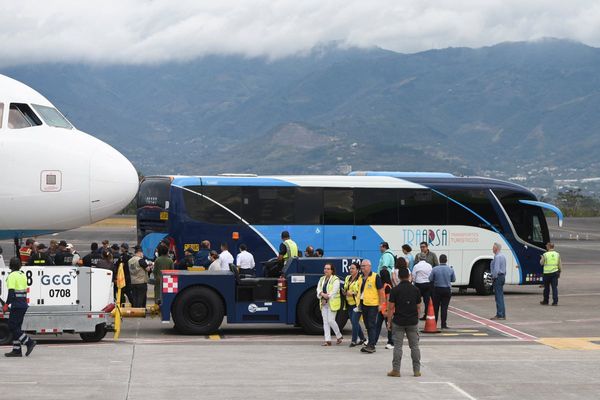
On the margins of a settlement in Shanta-abaq, in north-east Kenya, marabou storks surround a half-eaten camel carcass as people look on, distressed at yet another animal lost in a series of recent wildlife attacks.
The camel’s owner, who is away tending a dwindling herd, has lost seven of his livestock to hyena attacks since the beginning of the year, say community members. The attacks have become all too familiar with their signature strike: a fatal bite to the camel’s side as it sits by the waterpoint at night.
“You can see carcasses all over here. If you’re walking in this area, it’s hard to miss them,” says Shanta-abaq assistant area chief Abdi Kadir Dugow Mohamood, pointing to an area just beyond the residents’ makeshift settlement, which is lined with thorny tree stubs and animal remains. He adds: “There’s no night that camels are not being killed by hyenas or lions.”
Residents predict that the carcass will be gone by the morning – the hyenas are likely to return to finish it off at night. Onlookers from the neighbouring village of Gutale say it’s likely that Shanta-abaq residents will poison the half-eaten carcass to kill the hyena.

The country’s pastoralist communities, who live mainly in northern drylands, have coexisted peacefully with wildlife for years. But Kenya’s severe drought and sixth failed rainy season has led to conflict and competition for resources between people and wildlife.
A 2023 draft report by the Ministry of Tourism, Wildlife and Heritage and Kenya’s Wildlife Service, seen by the Guardian, said the number of negative incidents between communities and wildlife was at “national disaster levels”. People in the drylands are losing their livestock to a lack of water and pasture, and wildlife attacks, while wild animals have been pushed out of their traditional habitats by dwindling prey, a lack of water, blocked migration corridors, deforestation and poaching.
“If we fail to mobilise and create some kind of stability between wildlife and people with their livestock, I predict both sides suffering a great loss,” says Yussuf Hassan, 28, the manager of the Gutale community conservancy, one of 160 wildlife-protected areas managed by local people.
Dickson Kaelo, chief executive of the umbrella group Kenya Wildlife Conservancies Association, says human-wildlife conflict is the result of the conversion of traditional grazing spaces and wildlife habitats to agriculture and human settlements. “All these areas that were available during drought conditions for both livestock and wildlife to survive have largely been taken out of the system,” he says. “It creates a condition where it becomes inevitable that you’ll have this conflict.”
Herders say the drought has made their livestock easy prey. Camels, in particular, often travel alone, breaking away from the safety of the herd in search of water and pasture. Weak from the drought, many camels are unable to put up a fight when facing an ambush. As the drought stretches on, some pastoralists have resorted to feeding their camels ugali (boiled maize meal) or githeri (boiled maize and beans) to keep them alive.

Local administrators in Shanta-abaq are overrun with complaints from people who have lost livestock to wild animals. Residents can file compensation claims with the Kenya Wildlife Service (KWS), but the process is long and tedious, and many residents do not have the resources to see it through. Not a single case for compensation in Shanta-abaq has been successful, says Mohamood. Across the country, roughly 5.7bn Kenyan shillings (£34m) in claims have yet to be settled, which has left many people disillusioned. KWS did not respond to requests for an interview.
Kenya has lost nearly 70% of its wildlife over the past three decades, according to the Kenya Wildlife Conservancies Association, and 2022 drought reports show that more than 1,000 deaths occurred in conservancies over just a few months last year.
Conservationists say that wildlife services in the north and north-east of Kenya are under-resourced and underfunded, since the region is not traditionally associated with tourism. Yet the drylands are home to more than 70% of the country’s wildlife population, including endangered species such as the hirola antelope, Somali giraffe and Grévy’s zebra, according to the country’s first wildlife census in 2021.

Cases of poaching and bushmeat hunting in Gutale, Shanta-abaq and the surrounding areas have grown in recent years, say local wildlife activists.
A majority of Kenya’s wildlife lives outside government-protected areas, so community conservancies can play an important role conservation. Biodiversity outcomes are better in community conservancies than elsewhere, but conservation, which is largely funded by donor money, is fraught in Kenya, and has faced mounting criticism for positioning itself as being community-oriented while excluding, exploiting or offering minimal benefit to community members.

In 2019, Hassan started the 66,000 hectare (165,000 acre) Bora’ana conservancy. It is run and managed by the community, but has only six volunteer scouts; they get around mainly by foot, and occasionally by motorcycle, so are only able to patrol parts of the conservancy a few times a week. The scouts help wild animals cope during the drought: leaving water points open at night for their use, rescuing stranded or weak animals, and watching out for loggers who cut trees indiscriminately, leaving little for wildlife.
The scouts say that as the drought has worsened, people from Dadaab refugee camp 100km north have started killing animals on the conservancy to sell. Regular cow or goat meat is costly and less available due to increased livestock deaths, so there’s a ready market for giraffe or camel meat – which sells for lower prices.
“Near the Dadaab camp, the wildlife is over. There’s nothing to take care of. The animals are even escaping [poachers] down here into towns, and sometimes get stranded,” says Hajir Mohamed, 24, a scout.
Just a few years ago, he says, animals such as elephants and Grévy zebras could be spotted in the conservancy, but they have now perished.
Over the past three years alone, Bora’ana has lost 84 reticulated giraffes. Scouts give accounts of animals being skinned at night by men who arrive in large cars. Some poachers use motorbikes to chase down the giraffes until they are too tired to run. The poachers also recruit local people to get a lay of the land.

While community members say the conservancy has deterred poachers and loggers, scouts say there are limits to their work: they are not professional rangers, they are unarmed and have little to no legitimacy outside their community.
“We have been living alongside [wildlife] and yet other people are killing them senselessly,” says Mohamed.
Khalid Duale, 25, a scout, whose family has lived in Gutale for generations, fears that if the situation continues, his children may not grow up seeing the wildlife he has had around his entire life. He says: “I do this work so that my children can also see these animals. Going by the situation now, things are looking bleak.”







